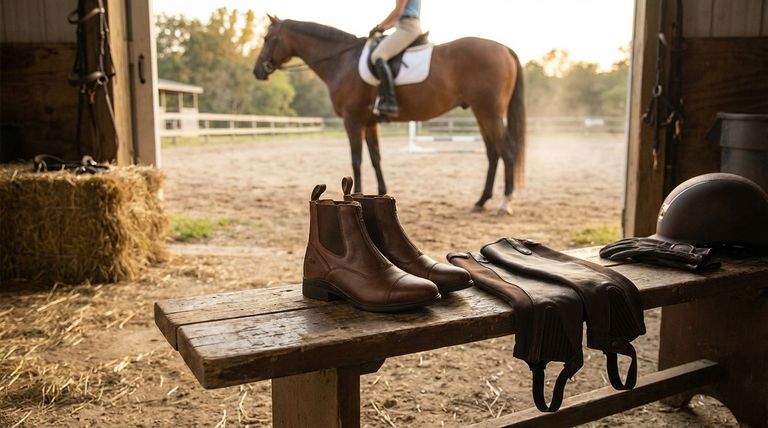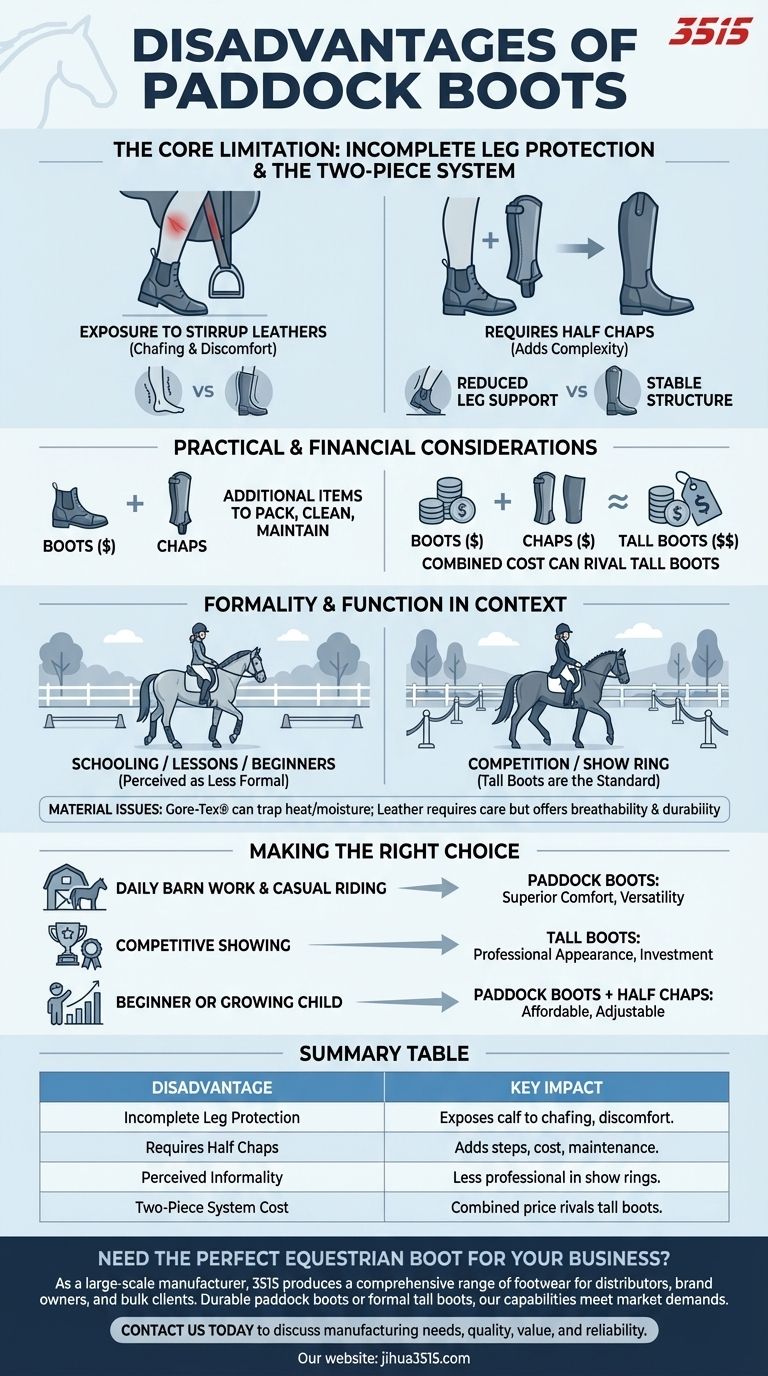The primary disadvantages of paddock boots are their lack of lower leg protection, the necessity of pairing them with half chaps for proper riding, and a perception that they are less formal than tall boots in competitive show environments. This makes them a versatile but incomplete solution on their own.
While paddock boots offer excellent comfort for groundwork and daily riding, their core drawback is that they function as part of a two-piece system. They require the addition of half chaps to provide the protection and leg stability that a tall boot offers in a single unit.

The Core Limitation: Incomplete Leg Protection
Paddock boots are, by design, short boots that stop just above the ankle. This creates immediate functional gaps for equestrian activities that must be addressed by additional gear.
Exposure to Stirrup Leathers
The most significant issue is the lack of a barrier between your calf and the saddle. Stirrup leathers will rub and pinch the rider's unprotected leg, causing discomfort, chafing, and bruising.
Reduced Leg Support
A tall boot provides a rigid structure that supports the rider's lower leg, helping to keep it stable and still. A paddock boot alone offers no such support, leading to a less secure leg position.
The Half Chap "Solution"
To solve these problems, riders wear half chaps over their paddock boots. This leather or synthetic covering protects the leg and adds grip, effectively mimicking the function of a tall boot. This necessity, however, is a fundamental disadvantage of the boot itself.
Practical & Financial Considerations
The need to create a complete system from two separate parts introduces trade-offs in convenience, cost, and maintenance compared to an all-in-one tall boot.
The Two-Piece System
Using paddock boots for serious riding means putting on two pieces of equipment—boots and half chaps—for each leg. This adds an extra step when preparing to ride and an extra item to pack, clean, and maintain.
The Combined Cost
While paddock boots are less expensive than tall boots, you must factor in the price of a quality pair of half chaps. The combined cost can approach or even exceed that of an entry-level pair of tall boots.
Understanding the Trade-offs: Formality and Function
The choice between paddock boots and tall boots often comes down to the context of your riding, particularly when moving from casual riding to competition.
The Perception in the Show Ring
In disciplines like hunters, equitation, and dressage, tall boots are the standard for a formal, polished appearance. Paddock boots with half chaps are often seen as more appropriate for schooling, lessons, or for young children in beginner divisions. While clean, well-fitting half chaps can look sleek, they may be perceived as less professional at higher levels of competition.
Material and Durability Concerns
When selecting any boot, the material impacts its function. Some waterproof paddock boots with synthetic linings like Gore-Tex can trap heat and moisture, leading to sweaty feet. Over time, these waterproof membranes can also degrade and fail, while high-quality leather boots, if properly cared for, offer better breathability and long-term durability.
Making the Right Choice for Your Riding Needs
Ultimately, the "disadvantages" of paddock boots are relative to your specific goals as a rider.
- If your primary focus is daily barn work and casual riding: The comfort, versatility, and ease of walking in paddock boots make them a superior choice.
- If your primary focus is competitive showing in formal disciplines: Tall boots are the established standard and a worthwhile investment for a professional appearance.
- If you are a beginner or a growing child: The combination of paddock boots and half chaps offers a more affordable and adjustable system.
Choosing the right footwear is about selecting the correct tool for your specific discipline and level.
Summary Table:
| Disadvantage | Key Impact |
|---|---|
| Incomplete Leg Protection | Exposes calf to stirrup leathers, causing discomfort and chafing. |
| Requires Half Chaps | Adds an extra step, cost, and item to maintain for proper riding. |
| Perceived Informality | Often seen as less professional than tall boots in competitive show rings. |
| Two-Piece System Cost | Combined price of boots and chaps can rival that of a single tall boot. |
Need the Perfect Equestrian Boot for Your Business?
As a large-scale manufacturer, 3515 produces a comprehensive range of footwear for distributors, brand owners, and bulk clients. Whether your customers need durable paddock boots for daily use or formal tall boots for competition, our production capabilities encompass all types of shoes and boots to meet your specific market demands.
Contact us today to discuss your manufacturing needs and discover how we can deliver quality, value, and reliability.
Visual Guide

Related Products
- Safety Footwear Wholesale Manufacturer for Custom OEM/ODM Production
- Durable Leather Tactical Boots Wholesale & Custom Manufacturing for Brands
- Premium Wholesale Waterproof Safety Boots High Performance Protection for Industrial Markets
- Customizable Anti-Smash Safety Boots for Wholesale & Private Label Manufacturing
- Premium Grain Leather Safety Boots for Bulk Supply
People Also Ask
- How long can you wear safety boots? The Lifespan is Determined by Wear, Not Time
- Is safety-toe as good as steel toe? Choose the Right Protection for Your Job
- What are the cultural perspectives on wearing shoes in the house? A Guide to Home Etiquette & Hygiene
- How do safety shoes contribute to cost savings for companies? A Strategic Investment in Risk and Cost Management
- Do snake bite boots work? Your Ultimate Guide to Effective Snake Bite Protection



















